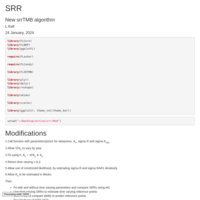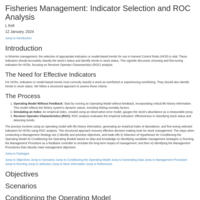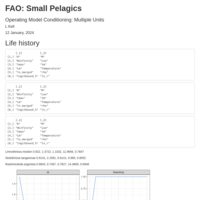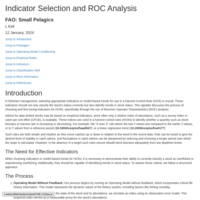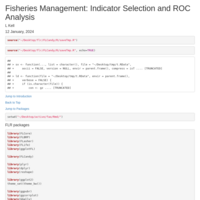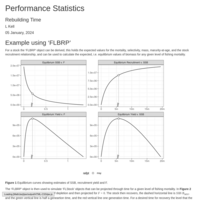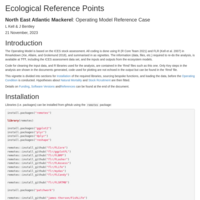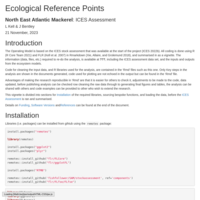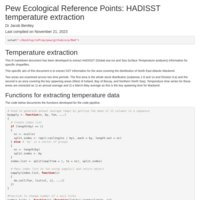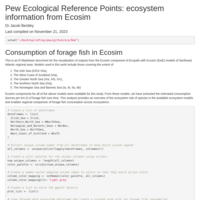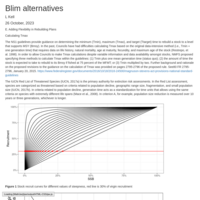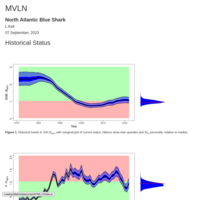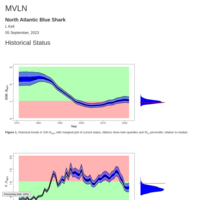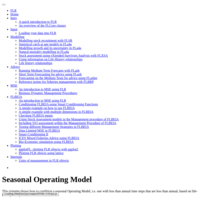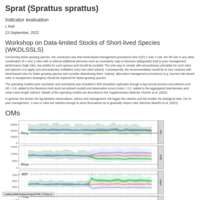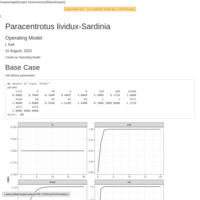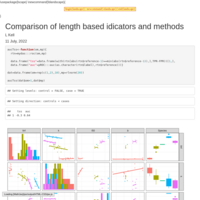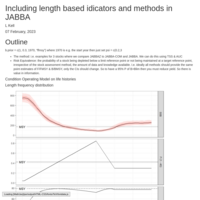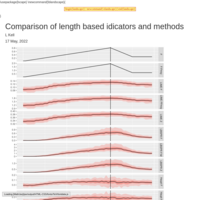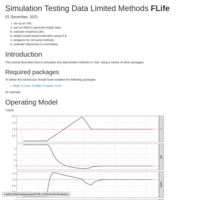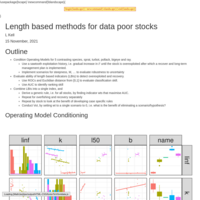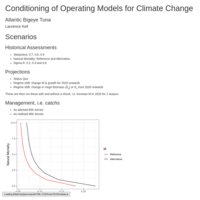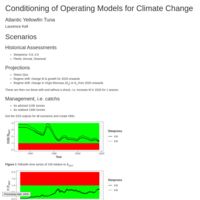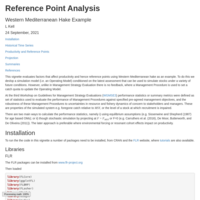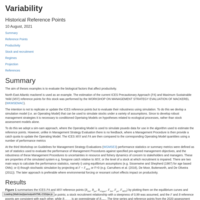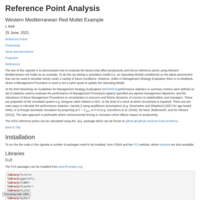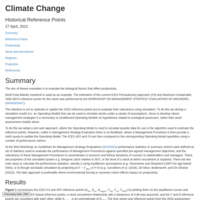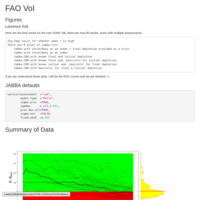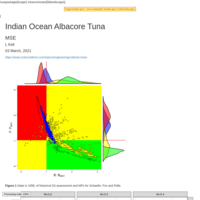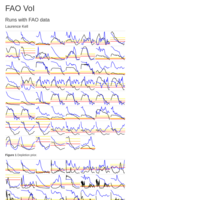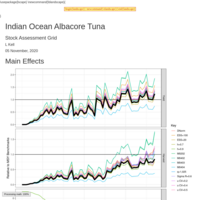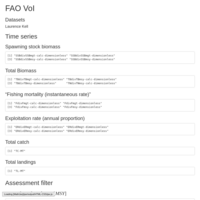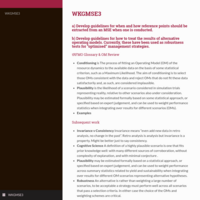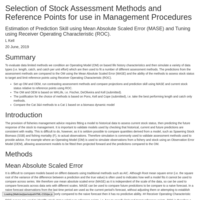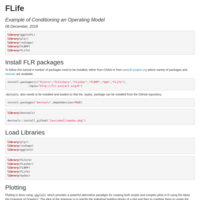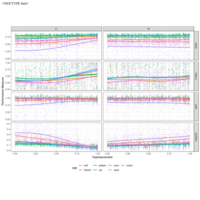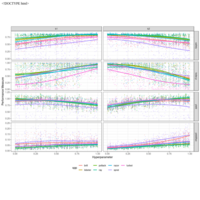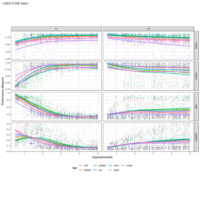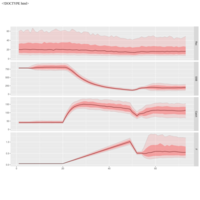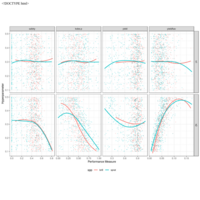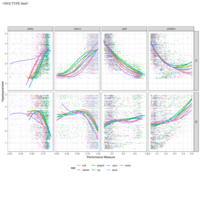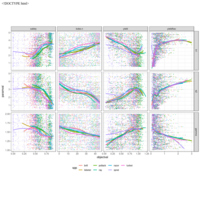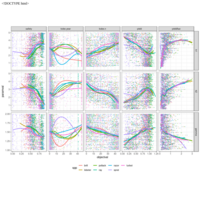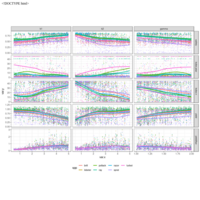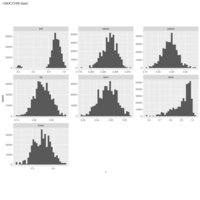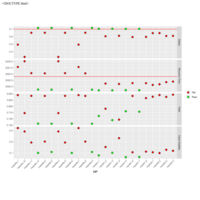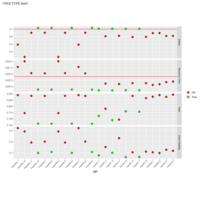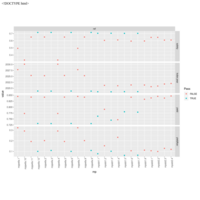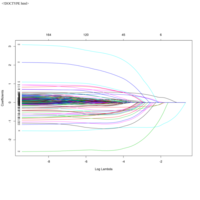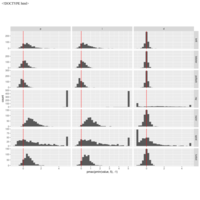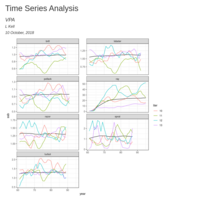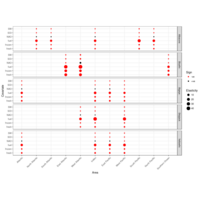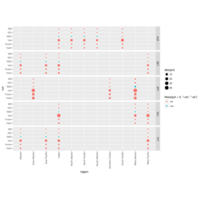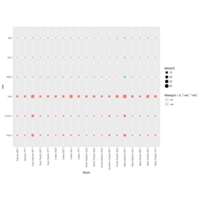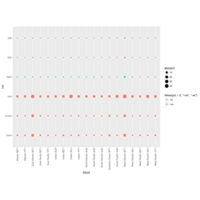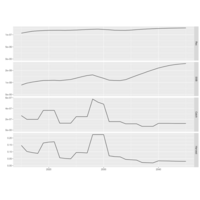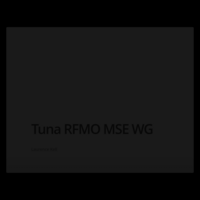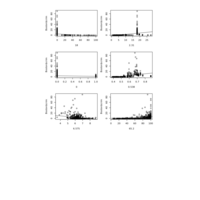Recently Published

DocumenToR A
Term of Reference (a): Assess whether conservation, technical and management measures are compatible for the purpose of stock conservation and management of targeted fish stocks and bycatch fish stocks in their entirety.

Simulation Framework
Assessment of Conservation and Technical Measures for Barents Sea Fish Stock Management

WKCB2 Working Group
ToR A: Assessment of Conservation and Technical Measures for Barents Sea Fish Stock Management

ICES Cat 1 stocks
Time series and production functions
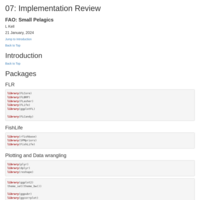
07: Implementation Review
This vignette is part of a framework to provide integrated fisheries management advice for fisheries limited by data and capacity. It focuses on the use of length-based indicators (LBI) and other methodologies to develop feedback control management strategies in freshwater systems such as Lake Tanganyika. The framework is a collaborative effort between the Assessment & Management Team of the FAO Fisheries and Aquaculture Division and the Fish4ACP Program. The document also provides a summary of the code repository with reproducible examples in the form of vignettes that can be extended in the future to a range of case studies.

06:
This vignette is part of a framework to provide integrated fisheries management advice for fisheries limited by data and capacity. It focuses on the use of length-based indicators (LBI) and other methodologies to develop feedback control management strategies in freshwater systems such as Lake Tanganyika. The framework is a collaborative effort between the Assessment & Management Team of the FAO Fisheries and Aquaculture Division and the Fish4ACP Program. The document also provides a summary of the code repository with reproducible examples in the form of vignettes that can be extended in the future to a range of case studies.
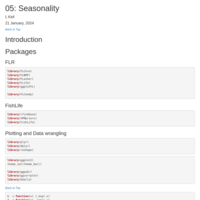
05: Seasonality
This vignette is part of a framework to provide integrated fisheries management advice for fisheries limited by data and capacity. It focuses on the use of length-based indicators (LBI) and other methodologies to develop feedback control management strategies in freshwater systems such as Lake Tanganyika. The framework is a collaborative effort between the Assessment & Management Team of the FAO Fisheries and Aquaculture Division and the Fish4ACP Program. The document also provides a summary of the code repository with reproducible examples in the form of vignettes that can be extended in the future to a range of case studies.
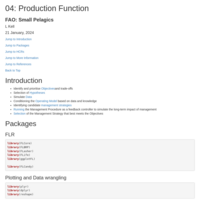
04: Production Function
This vignette is part of a framework to provide integrated fisheries management advice for fisheries limited by data and capacity. It focuses on the use of length-based indicators (LBI) and other methodologies to develop feedback control management strategies in freshwater systems such as Lake Tanganyika. The framework is a collaborative effort between the Assessment & Management Team of the FAO Fisheries and Aquaculture Division and the Fish4ACP Program. The document also provides a summary of the code repository with reproducible examples in the form of vignettes that can be extended in the future to a range of case studies.
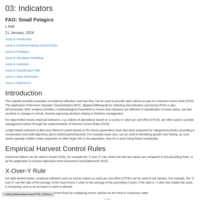
03: Indicators
This vignette is part of a framework to provide integrated fisheries management advice for fisheries limited by data and capacity. It focuses on the use of length-based indicators (LBI) and other methodologies to develop feedback control management strategies in freshwater systems such as Lake Tanganyika. The framework is a collaborative effort between the Assessment & Management Team of the FAO Fisheries and Aquaculture Division and the Fish4ACP Program. The document also provides a summary of the code repository with reproducible examples in the form of vignettes that can be extended in the future to a range of case studies.
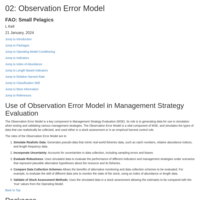
02: Observation Error Model
This vignette is part of a framework to provide integrated fisheries management advice for fisheries limited by data and capacity. It focuses on the use of length-based indicators (LBI) and other methodologies to develop feedback control management strategies in freshwater systems such as Lake Tanganyika. The framework is a collaborative effort between the Assessment & Management Team of the FAO Fisheries and Aquaculture Division and the Fish4ACP Program. The document also provides a summary of the code repository with reproducible examples in the form of vignettes that can be extended in the future to a range of case studies.
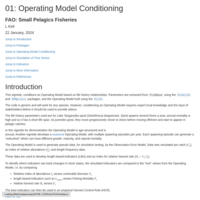
01: Operating Model Conditioning
This vignette is part of a framework to provide integrated fisheries management advice for fisheries limited by data and capacity. It focuses on the use of length-based indicators (LBI) and other methodologies to develop feedback control management strategies in freshwater systems such as Lake Tanganyika. The framework is a collaborative effort between the Assessment & Management Team of the FAO Fisheries and Aquaculture Division and the Fish4ACP Program. The document also provides a summary of the code repository with reproducible examples in the form of vignettes that can be extended in the future to a range of case studies.

00: Installation
This vignette is part of a framework to provide integrated fisheries management advice for fisheries limited by data and capacity. It focuses on the use of length-based indicators (LBI) and other methodologies to develop feedback control management strategies in freshwater systems such as Lake Tanganyika. The framework is a collaborative effort between the Assessment & Management Team of the FAO Fisheries and Aquaculture Division and the Fish4ACP Program. The document also provides a summary of the code repository with reproducible examples in the form of vignettes that can be extended in the future to a range of case studies.

07: Implementation Review
This vignette is part of a framework to provide integrated fisheries management advice for fisheries limited by data and capacity. It focuses on the use of length-based indicators (LBI) and other methodologies to develop feedback control management strategies in freshwater systems such as Lake Tanganyika. The framework is a collaborative effort between the Assessment & Management Team of the FAO Fisheries and Aquaculture Division and the Fish4ACP Program. The document also provides a summary of the code repository with reproducible examples in the form of vignettes that can be extended in the future to a range of case studies.
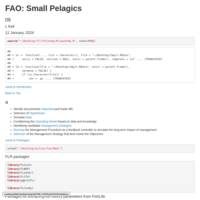
06: Running an MSE
This vignette is part of a framework to provide integrated fisheries management advice for fisheries limited by data and capacity. It focuses on the use of length-based indicators (LBI) and other methodologies to develop feedback control management strategies in freshwater systems such as Lake Tanganyika. The framework is a collaborative effort between the Assessment & Management Team of the FAO Fisheries and Aquaculture Division and the Fish4ACP Program. The document also provides a summary of the code repository with reproducible examples in the form of vignettes that can be extended in the future to a range of case studies.

05: Seasonality
This vignette is part of a framework to provide integrated fisheries management advice for fisheries limited by data and capacity. It focuses on the use of length-based indicators (LBI) and other methodologies to develop feedback control management strategies in freshwater systems such as Lake Tanganyika. The framework is a collaborative effort between the Assessment & Management Team of the FAO Fisheries and Aquaculture Division and the Fish4ACP Program. The document also provides a summary of the code repository with reproducible examples in the form of vignettes that can be extended in the future to a range of case studies.

04: Harvest Control Rules
This vignette is part of a framework to provide integrated fisheries management advice for fisheries limited by data and capacity. It focuses on the use of length-based indicators (LBI) and other methodologies to develop feedback control management strategies in freshwater systems such as Lake Tanganyika. The framework is a collaborative effort between the Assessment & Management Team of the FAO Fisheries and Aquaculture Division and the Fish4ACP Program. The document also provides a summary of the code repository with reproducible examples in the form of vignettes that can be extended in the future to a range of case studies.
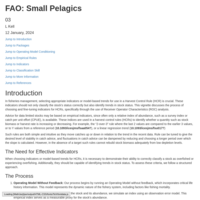
03: Indicators of stock trends and status
This vignette is part of a framework to provide integrated fisheries management advice for fisheries limited by data and capacity. It focuses on the use of length-based indicators (LBI) and other methodologies to develop feedback control management strategies in freshwater systems such as Lake Tanganyika. The framework is a collaborative effort between the Assessment & Management Team of the FAO Fisheries and Aquaculture Division and the Fish4ACP Program. The document also provides a summary of the code repository with reproducible examples in the form of vignettes that can be extended in the future to a range of case studies.

02: Observation Error Model
This vignette is part of a framework to provide integrated fisheries management advice for fisheries limited by data and capacity. It focuses on the use of length-based indicators (LBI) and other methodologies to develop feedback control management strategies in freshwater systems such as Lake Tanganyika. The framework is a collaborative effort between the Assessment & Management Team of the FAO Fisheries and Aquaculture Division and the Fish4ACP Program. The document also provides a summary of the code repository with reproducible examples in the form of vignettes that can be extended in the future to a range of case studies.
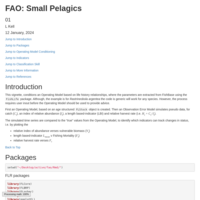
01: Operating Model Conditioning
This vignette is part of a framework to provide integrated fisheries management advice for fisheries limited by data and capacity. It focuses on the use of length-based indicators (LBI) and other methodologies to develop feedback control management strategies in freshwater systems such as Lake Tanganyika. The framework is a collaborative effort between the Assessment & Management Team of the FAO Fisheries and Aquaculture Division and the Fish4ACP Program. The document also provides a summary of the code repository with reproducible examples in the form of vignettes that can be extended in the future to a range of case studies.
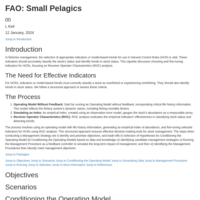
00: Introduction and Installation
This vignette is part of a framework to provide integrated fisheries management advice for fisheries limited by data and capacity. It focuses on the use of length-based indicators (LBI) and other methodologies to develop feedback control management strategies in freshwater systems such as Lake Tanganyika. The framework is a collaborative effort between the Assessment & Management Team of the FAO Fisheries and Aquaculture Division and the Fish4ACP Program. The document also provides a summary of the code repository with reproducible examples in the form of vignettes that can be extended in the future to a range of case studies.

Adapt & Learn
Management Plan for Sea Urchin
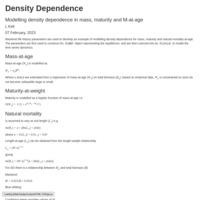
DD
Simulation of density dependence
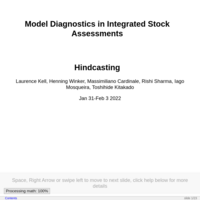
CAPAM Diagnostic Workshop: Hiundcasting
There two ways to conduct a hindcast based either on observations, i.e. crossvalidation, or model estimates, e.g. as a backtest. While there are three reasons for doing so, namely to find the "best assessment", select and weight models in an ensemble, or condition Operating and Observation Error Models when conducting Management Strategy Evaluation. We review how stock assessment models are currently validated, summarise the use of the hindcast by the RMFOs, and propose how to adopt hindcasting as an objective approach for selecting, screening and weighting hypotheses.
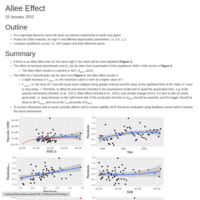
Allee Effects
Impact of Allee effects on reference points
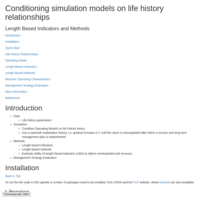
Conditioning simulation models on life history relationships: Length Based Indicators and Methods
Simulation testing of length-based methods, using Operating Models based on life history relationships

Length Based Indicators
Evaluation of LBIs for detecting overfishing and recovery.
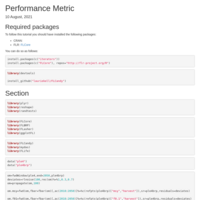
Performance Metrics
Examples of processing MSE outputs

Western Mediterranean Hake
Summary

NEA Mackerel Stock Recruitment Relationships
Beverton and Holt Stock Recruitment Relationships with two regimes, variable $SPR_0$ and autocorrelation.
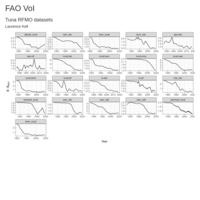
Tuna RFMO Stock Trends
Selected tuna RFMO stock trends relative to BMSY
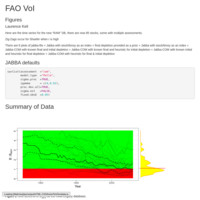
Evaluation of Catch-Only Models using the RAM Legacy DB
The RAM DB is used to generate data poor time series and then JABBA configured as a catch-only model is used to estimate final depletion. Results are then compared using Receiver Operator Characteristics

r Priors
Derivation of priors for population growth rate, based on the Leslie matrix using life history parameters

RAM Legacy Database Time Series
Summary of the data used to evaluate the catch-only models
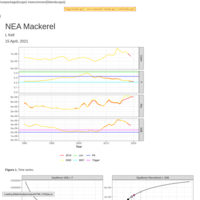
NEA Mackerel Reference Points
A comparison of reference points from the Operating Model and eqsim.
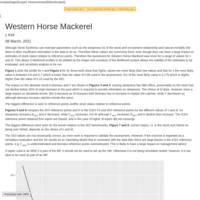
Western Horse Mackerel Reference Points
A comparison of reference points estimated by SS3, for different values of steepness and natural mortality, with those estimated by msy-tools
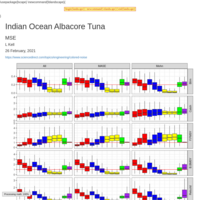
albio2
results from MSE

ALBIO MSE
Full set of plots
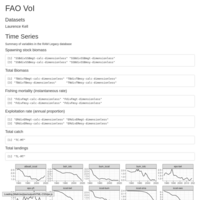
FAO-VoI
Summary of data in RAM Legacy database
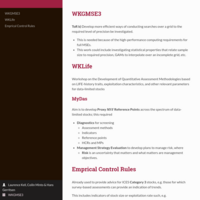
Empirical MP
Example of an empirical control rule developed using Machine Learning
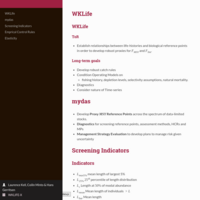
mydas examples for WKLIFEX
Examples of screening indicators, and using machine learning to conduct MSE

TEAMFish
Benchmarking

ICCAT Subcommittee on Ecosystems: 2020
Validation and Screening of Indicators: Sargasso Sea Case Study
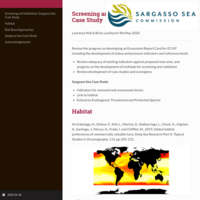
Sargasso Sea Case Study: EBFM
2020 ICCAT SUB-COMMITTEE ON ECOSYSTEM MEETING
4-6 May 2020
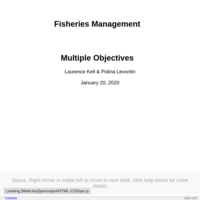
Pareto
Use Pareto Fronts to evaluate trade-offs
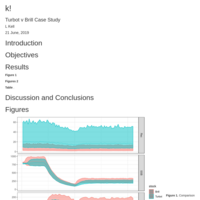
Turbot v Brill
Comparison of the dynamics of a low k stock (turbot) with a high k stock (brill)
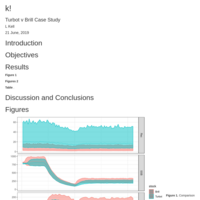
Paretos
Multiple trade-offs

Multi Objectives
Pareto Plots to show trade-offs
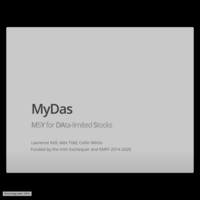
MyDas 12 Monthly Meeting
Update on work conducted under MyDas
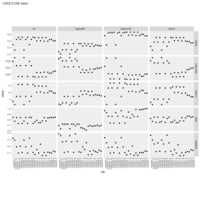
summary plot
Abacore
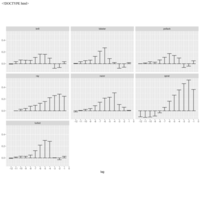
The cross correlations between recruitment and catch for a Cat 1 control rule
The cross correlations are plotted for negative lags between recruitment and catch, i.e. for lobster high catches occur 6 years after a strong recruitment, while for sprat they occur after 2 years.
The hypothesis is that the performance of a harvest control is determined by the variability in recruitment and the lag between catch and recruitment, rather than the life history parameters and the production function.
This can be tested by simulating stocks with different life history parameters and natural mortality vectors and various recruitment scenarios, then comparing the performance of the control rules
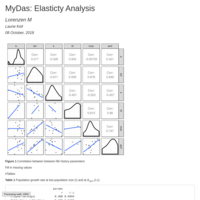
MyDas WKLIFE 2018
Mydas Presentation at WKLife

MyDas WKLIFE 2018
Summary of the MyDas project.
MyDas is funded by the Irish exchequer and EMFF 2014-2020, and the overall aim is to develop and test a range of assessment models and methods to establish Maximum Sustainable Yield (MSY), or proxy MSY reference points across the spectrum of data-limited stocks.
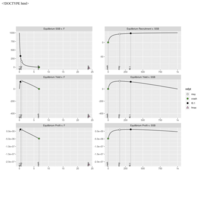
Plot
mey
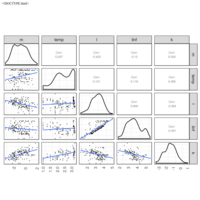
Plot
gislason

Plot
lh

Plot
life hist

Projection for constant F
Simulation of long-term constant Fishing Mortality to compare dynamic projections with equilibrium. Fs are for a range of per recruit reference points.
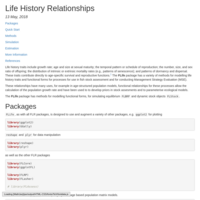
FLife
FLife Vignette
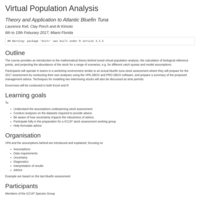
VPA Course
GBYP
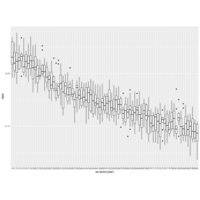
Plot P(L>Lmega)
Proportion of stock>Lmega, i.e. save the BOFFs
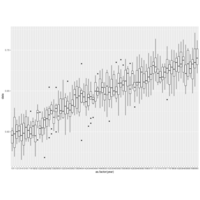
Plot of P(L<LMat)
Indicator based on proportion of stock below Length at Maturity

Simulated Stock
A large pelagic that was originally at virgin, then expoited increasingly heavily over 100 years
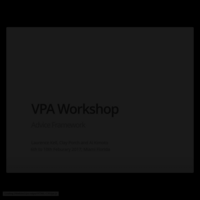
VPA Course
The Kobe Advice Framework

Publish Document
tentative course outline
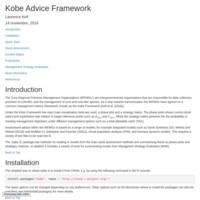
Publish Document
Kobe Vignette
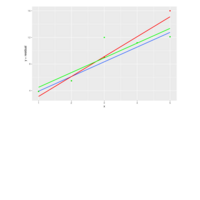
Publish Plot
test
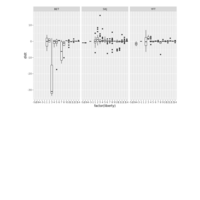
Publish Plot
dl/dt by days at liberty







